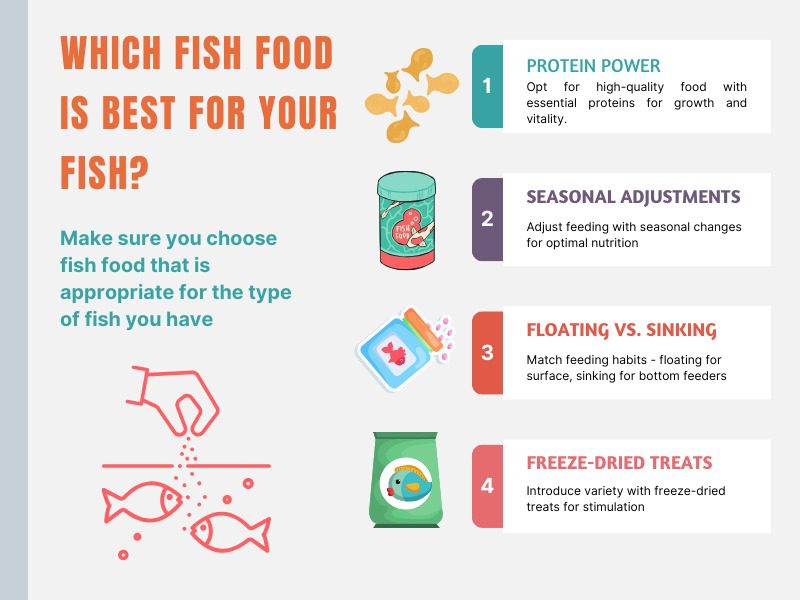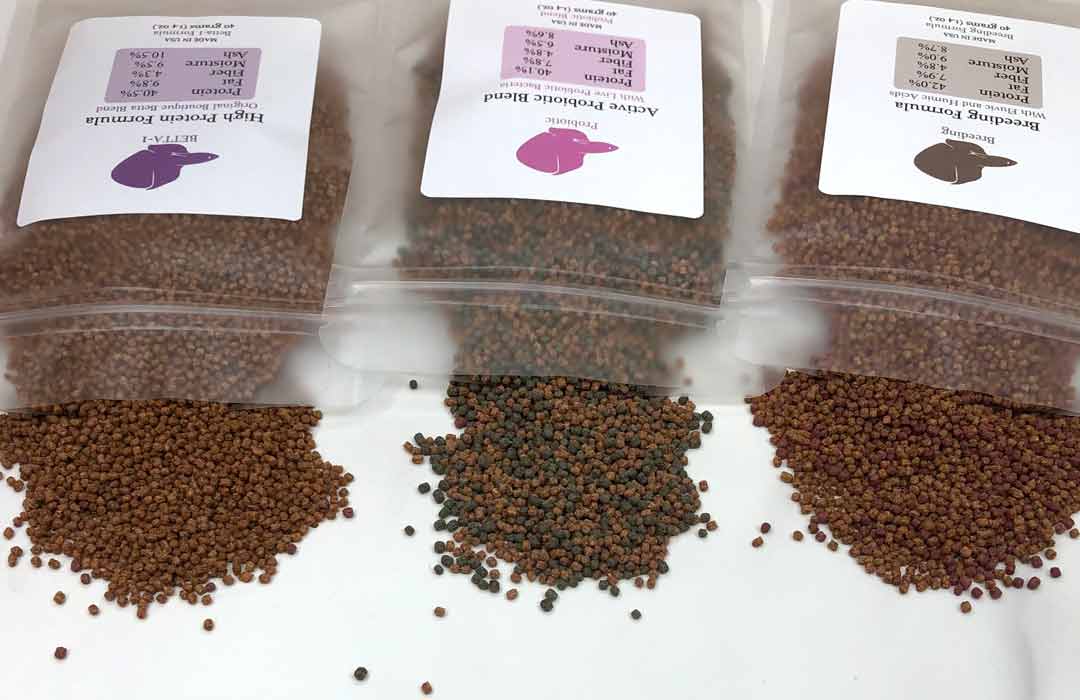Fish-Based Food Selection
Your fish should only be fed safe, nutrient-balanced food suitable for their species.

Flake and Pellet Foods
Various formulations for fish, such as herbivores, carnivores, community fish, and saltwater fish, are available for flake and pellet foods. For the majority of fish, these can make up an excellent staple diet.
Flake and pellets, however, lose much of their nutritional value when they come into contact with air; what was once tasty and nourishing becomes stale and useless. Foods that are pelleted or flake should be thrown out three months after opening.
Because flakes and pellets are frequently low in fiber, they can cause constipation, which can cause problems with the swim bladder and cause bloating in your fish. Vegetable meals and foods high in fiber, like daphnia, will aid in preventing this
Freezer-dried Foods for Fish
Freeze-dried fish meal has an excellent nutrient balance and valuable fiber. It is possible to effectively use freeze-dried fish meal as a supplement to flake and pellet meals or as the primary source of fish meal. These foods are incredibly safe because freeze-drying eliminates any possible pathogens, and most fish seem to find them very tasty.
The main disadvantage is cost: freeze-dried fish food costs more per unit than frozen fish food.
Refrigerated Foods for Fishes
Aquarium retailers offer a vast selection of frozen food products, from whole fish to zooplankton. Frozen foods are just as popular with aquarium fish as live ones despite being less expensive. They are, therefore, helpful in feeding finicky or predatory fish. In addition to being less likely to contain pathogens than live fish food, some manufacturers irradiate frozen food to ensure maximum safety.
Frozen fish food is very nutritious and often high in fiber due to its unprocessed nature. It’s a good idea to switch up your fish diet throughout the week, alternating between different foods like chopped mussels one day and mysids the next. Frozen food blends explicitly designed for community, cichlid, saltwater, and other fish avoid this issue by incorporating a well-selected combination of nutrition, occasionally with extra vitamins and greens added.
You can also use seafood sold for human consumption, such as prawns, mussels, clams, squid, and whitebait. Shrimp and prawns without shells are especially useful for feeding puffer fish and triggerfish as they wear down their rapidly growing teeth.
Feeder Fish
Despite any ethical considerations, serving feeder fish as food is controversial, with many seasoned aquarists rejecting them as needless and dangerous. Cheap feeder fish should never be used because they are raised in filthy conditions and are likely to be infected with parasites and diseases. The goldfish and minnows most frequently sold as feeder fish are too high in fat and thiaminase to be of any use. As the thiaminase breaks down vitamin B-1, the fat gradually damages the internal organs. Well-known saltwater aquarist Bob Fenner has even gone so far as to claim that the leading cause of lionfish deaths in home aquariums is the use of feeder goldfish.
Why even use feeder fish? Giving live fish to fish that are predators in the wild could be the simplest method of getting them to eat in captivity. However, you can almost always substitute frozen fish meals or other live foods in their place.
Raising your fish is the only safe option if you use feeder fish. Livebearers are advised because they are easy to grow and have a balanced diet. They ought to be fed a high-quality diet and kept in a healthy atmosphere.
Lives foods
The benefit of live food is that even recently imported wild-caught fish can immediately identify it as prey. Otherwise, fussy bottom feeders like spiny eels and mormyrids will eat worms and insect larvae, while piscivorous fish will take earthworms, river shrimp, and giant insects.
Live food is costly and inconvenient; frozen fish food, on the other hand, is much less expensive, and most fish will accept it just as readily. Pests and illnesses can also be introduced by aquatic live food. A few problems known to enter aquariums with live food are dragonfly larvae, hydra, and snails. Tubifex worms are known for spreading diseases like whirling and nodular illnesses from myxosporidian and microsporidian parasites.
While it’s true that brine shrimp are incredibly safe compared to other live food, adult brine shrimp are not nutrient-dense and should only be given to your fish as an occasional treat.
Fish Food's Algae and Additional Vegetables
Sushi Nori, a Japanese seaweed-based
dish commonly found in Asian grocery stores, is readily accepted by herbivorous
fish. It can be divided into smaller pieces for feeding tiny fish or fastened
to submerged “lettuce clips” so larger fish can graze at their own
pace. You can also use veggies. Cucumber and iceberg lettuce are popular but
have very little nutritional value; blanched curly lettuce, zucchini, and
canned peas are far better options. Fish that graze, such as plecos, like sweet
potatoes and sliced carrots.
For specific fish, wood is an
important food source. While most plecos appear to require some wood in their
diet as a source of dietary fiber, members of the Panaque genus digest wood and
will not thrive in captivity without it.
Fish can be fed in many ways, so the
type of fish you keep will determine what you feed them.
How to provide Foods for Various Fish Type
Community fish
Tetras, livebearers, and small community fish should only be fed once or twice a day. They only need to be provided as much food at each meal as they can finish in about a minute. There ought to never be any leftover food. For fish on the aquarium’s surface, use floating fish food; for species that stay close to the substrate, use sinking fish food.
Examine your livestock while feeding your fish. To make sure all the fish are there, start by counting them. Examine the fish for indications of illness or injury. Odd behavior is frequently the first indication of issues with aquarium water quality or fish health, especially during feeding times. Thus, look into it more if one or more of your fish aren’t interested in their food.
The abdomens of aquarium fish that are adequately fed should be gently rounded. Fish that are overfed appear bloated and are frequently lazy. Regularly malnourished fish will appear malnourished, often exhibiting a distinctly concave ventral profile.
Reef Fish Aquariums
When it comes to feeding, saltwater fish can be categorized into four basic types:
Audacious feeders
Plankton-consuming
Grazers that feed on plants
Small-scale predators
Saltwater fish like damselfish are bold feeders; they gleefully swim out into the open during feeding season. Feeding these fish one or two small meals each day is adequate.
Feeding plankton feeders can be more challenging; the main reason is that they require several small meals daily to thrive. The archetypal plankton-feeding fish, anthias, are easily starved in captivity due to their daily feeding requirements.
Herbivorous grazers are also frequently aggressive feeders, but they also require green foods in addition to flake or frozen food. Classic herbivores include saltwater angelfish and surgeonfish. They must always have access to live algae or an appropriate substitute, like nori.
Micropredators are organisms that eat small animals of various kinds, such as seahorses and mandarin fish. Copepods and other small crustaceans may be found in sufficient numbers in mature, huge aquariums for them to thrive, but relying solely on this has resulted in the death of countless fish. Alternatively, the aquarist will need to supply live or frozen substitutes at least once a day. Micropredators have unique requirements, and their feeding habits are often slow, so avoiding mixing them with community species is best.
Certain invertebrates, like algae-eating snails, will find food on their own in reef aquariums, but others require food to be provided by the aquarist.
Nocturnal Fish
Because the aquarist cannot always tell if a specific fish is eating the food left out for it, feeding nocturnal fish can be challenging. This is particularly true for nocturnal predators such as mormyrids and spiny eels. Keep these slow-feeding species separate from anything that could consume their food, like loaches or catfish. Feed nocturnal animals five times a week or so.
Large Predatory Fish
Of course, most fish are predators, but for various reasons, large predators are classified differently. They don’t have to eat every single day to start. Feeding large predators like piranhas and catfish may only be necessary a few times a week.
Second, these fish often gorge themselves in the wild, eating a large prey item and then going days without eating anything else. Whether this is a wise strategy for an aquarium is debatable, as the ammonia spike that follows a large meal can lead to severe water quality issues. To make matters worse, some predators regurgitate undigested food if they overeat. Serving small meals several times a week or even daily is the safest course of action. The objective remains to keep the abdomen softly rounded rather than swollen.
Lastly, anecdotal evidence suggests that predatory fish become more aggressive when utilizing live prey instead of dead. As was previously mentioned, feeder fish ought to be avoided.
Herbivorous Fish
When provided with consistent access to appropriate green foods, herbivores thrive. Plant material doesn’t affect water quality because it is low in protein.
Juvenile Fish
Fish younger than three months old, known as juveniles, thrive when fed multiple small meals throughout the day. Feeding very young fish—those younger than one month—up to six times a day is advised. Algae you have carefully allowed to grow in the aquarium may be one of those meals.
Fish Fooding While on Vacation
You could quickly go up to seven days without feeding a mature aquarium. You have a few choices if you want to stay for longer. Large fish, especially predators, can quickly go for two weeks or longer without eating if they are healthy. Give cheap aquarium plants like pondweed to herbivores like goldfish and let them fend for themselves. Automated feeders can typically be used to provide for community aquariums. Since you won’t be there to remove waste or change the water, it makes sense to reduce the rations.




